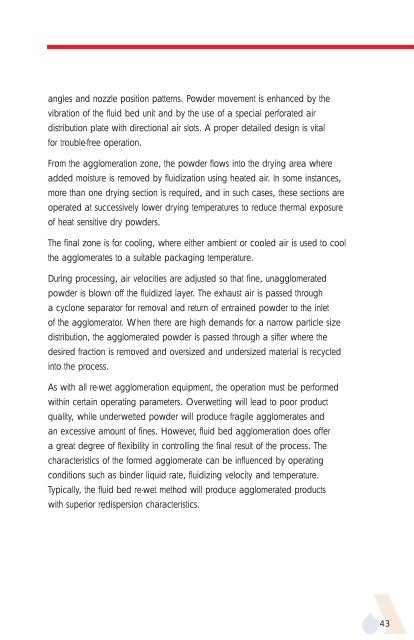APV Dryer Handbook - Umbc
APV Dryer Handbook - Umbc
APV Dryer Handbook - Umbc
You also want an ePaper? Increase the reach of your titles
YUMPU automatically turns print PDFs into web optimized ePapers that Google loves.
angles and nozzle position patterns. Powder movement is enhanced by the<br />
vibration of the fluid bed unit and by the use of a special perforated air<br />
distribution plate with directional air slots. A proper detailed design is vital<br />
for trouble-free operation.<br />
From the agglomeration zone, the powder flows into the drying area where<br />
added moisture is removed by fluidization using heated air. In some instances,<br />
more than one drying section is required, and in such cases, these sections are<br />
operated at successively lower drying temperatures to reduce thermal exposure<br />
of heat sensitive dry powders.<br />
The final zone is for cooling, where either ambient or cooled air is used to cool<br />
the agglomerates to a suitable packaging temperature.<br />
During processing, air velocities are adjusted so that fine, unagglomerated<br />
powder is blown off the fluidized layer. The exhaust air is passed through<br />
a cyclone separator for removal and return of entrained powder to the inlet<br />
of the agglomerator. When there are high demands for a narrow particle size<br />
distribution, the agglomerated powder is passed through a sifter where the<br />
desired fraction is removed and oversized and undersized material is recycled<br />
into the process.<br />
As with all re-wet agglomeration equipment, the operation must be performed<br />
within certain operating parameters. Overwetting will lead to poor product<br />
quality, while underwetted powder will produce fragile agglomerates and<br />
an excessive amount of fines. However, fluid bed agglomeration does offer<br />
a great degree of flexibility in controlling the final result of the process. The<br />
characteristics of the formed agglomerate can be influenced by operating<br />
conditions such as binder liquid rate, fluidizing velocity and temperature.<br />
Typically, the fluid bed re-wet method will produce agglomerated products<br />
with superior redispersion characteristics.<br />
43











